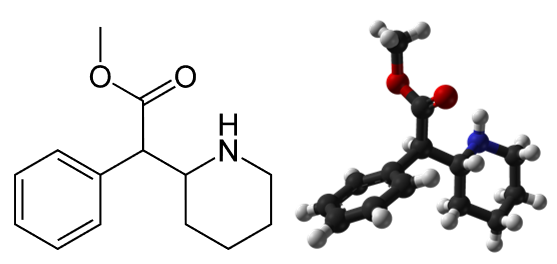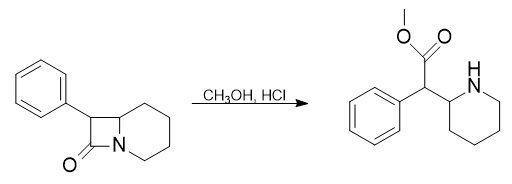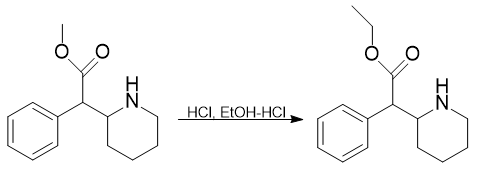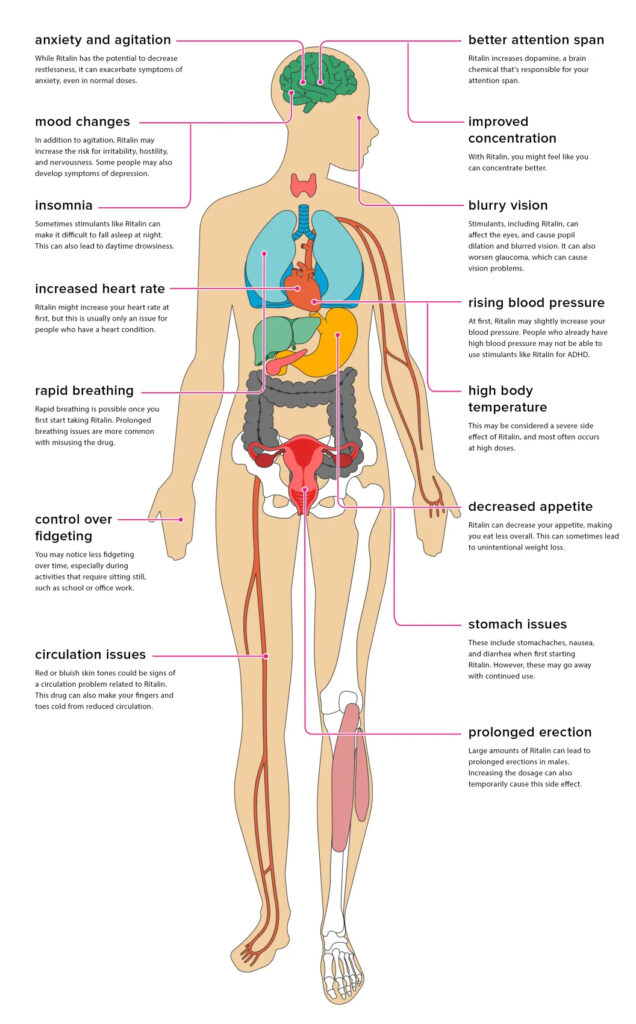Introduction
Methylphenidate (Ritalin) CAS 298-59-9 was first synthesized in 1944 by chemist Leandro Panizzon and sold by Swiss company CIBA (now Novartis).
Methylphenidate is a potent central nervous system (CNS) stimulant widely recognized for its therapeutic use, particularly in the treatment of Attention Deficit Hyperactivity Disorder (ADHD) and narcolepsy. Pharmacologically, methylphenidate exerts its effects by blocking the dopamine and norepinephrine transporters, which increases the levels of these neurotransmitters in the synaptic cleft. This action is primarily responsible for its use in managing ADHD symptoms such as inattention, hyperactivity, and impulsivity, and for promoting wakefulness in individuals with narcolepsy.
Many people use methylphenidate to help them stay alert, stay awake for many hours at a time, and maintain abnormally high levels of concentration. This use has caused methylphenidate to become one of the most abused prescription drugs. Methylphenidate effects similar to those produced by cocaine and amphetamines.
However, the potent effects of methylphenidate come with a range of safety considerations. While generally safe for most users when taken as prescribed, it can cause side effects such as insomnia, decreased appetite, and increased heart rate. More serious concerns include potential for abuse, dependency, and long-term cardiovascular risks.
This introduction provides a concise overview of methylphenidate, its chemical and physical properties, synthesis and reactions, applications, and safety precautions.

Physical and Chemical Properties of Methylphenidate
Methylphenidate, Ritalin, [Methyl phenyl (piperidin-2-yl) acetate hydrochloride], CAS 298-59-9, is a piperidine-based stimulant with the chemical formula C14H19NO2*HCl and a molecular weight of 269.77 g/mol. Methylphenidate appears as a white, odorless, crystalline powder. Its melting point is 225°C and boiling point 327.6 at 760 mm Hg. Density of methylphenidate is about: 1.1±0.1 g/mL (at 20 °C). Methylphenidate is soluble in ethanol (29.3 mg/ml) and water (18.6 mg/ml).
Synthesis of Methylphenidate
The synthesis of methylphenidate CAS 298-59-9 is a process that combines principles of organic chemistry, specifically focusing on the formation of the core of the molecule. The synthesis route for methylphenidate typically involves several key steps, each critical for constructing the molecule’s complex structure efficiently and effectively.
- Formation of nitrile:
The synthesis of methylphenidate begins with the preparation of the piperidine core, which is essential for its activity. A common starting material for this core is 2-cloropyridine, which can be converted into 2-phenyl-2-(pyridin-2-yl) acetonitrile via condensation of phenylacetonitrile in toluene in the presence of sodium amide.

- Formation of amide:
2-Phenyl-2-(pyridin-2-yl)acetonitrile hydrolyzed by sulfuric acid to corresponding amide, 2-phenyl-2-(piperidin-2-yl)acetamid.

Preparation of methyl 2-phenyl-2-(pyridin-2-yl)acetate from 2-phenyl-2-(pyridin-2-yl)acetonitrile.
- Formation of acetate:
2-Phenyl-2-(piperidin-2-yl)acetamid on treatment with hydrochloric acid in methanol on heating gave methyl 2-phenyl-2-(pyridin-2-yl)acetate.

- Synthesis of methylphenidate:
Hydrogenation of the pyridine ring to a piperidine ring, methyl 2-phenyl-2-(pyridin-2-yl)acetate to obtain product in acid on the platinum or platinum dioxide catalyst gave the desired methylphenidate.

Another method to synthesis methylphenidate
To a solution of 1-phenyl-2-(piperidin-1-yl)ethane-1,2-dione in dimethoxyethane added p-toluenesulfonhydrazide at room temperature. This solution cooled to 0 °C and anhydrous hydrochloric acid gas bubbled through the solution. The reaction mixture refluxes for 3-12 hours. The precipitate collected by filtration and subsequently allowed to air dry to give tosylhydrazone.

After to a solution of tosylhydrazone in toluene added a solution of potassium tert-butoxide in tertbutanol at room temperature. The resulting oil or semi-solid yielded a diastereomer of B-lactam.

In the end a solution of B-lactam in methanol at 0 °C react with anhydrous hydrochloric acid gas. The white solid of methylphenidate can be obtained.

These synthetic routes demonstrate the chemical complexity and ingenuity required in pharmaceutical synthesis. Each step must be carefully controlled to ensure the reaction proceeds correctly.

Chemical Reactions of Methylphenidate
Methylphenidate CAS 298-59-9 can react with ethanol to form ethylphenidate by transesterification under controlled conditions. This reaction is not generally performed in routine therapeutic applications but can be explored for creating analogs with potentially different pharmacological properties.

Another reaction of methylphenidate is hydrolysis. Hydrochloric acid used as catalyst. After hydrolysis, ritalinic acid can be obtained.

These reactions can be interest in the development of new drug or in the synthesis of compounds for research purposes.
Applications of Methylphenidate
Methylphenidate CAS 298-59-9 is a central nervous system stimulant with a broad range of applications primarily centered on its ability to increase attention and decrease impulsiveness and hyperactivity in patients diagnosed with Attention Deficit Hyperactivity Disorder (ADHD). Beyond its primary use, methylphenidate is also employed in several other clinical and off-label applications due to its neurostimulator properties.
Treatment of Obesity and Weight Management
Emerging research has investigated the use of methylphenidate as an adjunct in the treatment of obesity. Methylphenidate ‘s appetite-suppressing properties can potentially aid in weight management, particularly in patients whose eating habits are influenced by ADHD-related impulsivity. However, this application is still under research, and methylphenidate is not widely prescribed for obesity pending further evidence.
Recreational Use of Methylphenidate
Methylphenidate, ritalin is a prescribed medication used as a common treatment for attention deficit hyperactivity. Many people use methylphenidate to remain alert, to stay awake for many hours in a row and maintain abnormally high levels of concentration. This use has caused methylphenidate to become one of the most abused prescription drugs. Methylphenidate effects similar to those produced by cocaine and amphetamines.
Pharmaceutical Synthesis
Methylphenidate is a intermediate in the synthesis of various pharmacologically active compounds. Its piperidine-based structure and stereochemistry serve as a template for developing analogs with potentially enhanced therapeutic properties or different pharmacokinetic profiles. Researchers modify the methylphenidate to create new drugs targeting the central nervous system. For example, analogs of methylphenidate are being investigated for their potential use in treating cognitive disorders, depression, and other neuropsychiatric conditions.

Pharmacology of Methylphenidate
Methylphenidate, CAS 298-59-9, primarily acts as a central nervous system (CNS) stimulant, exerting its effects by increasing the levels of the neurotransmitters dopamine and norepinephrine in the brain. This is achieved by inhibiting the reuptake of these neurotransmitters through their respective transporters: the dopamine transporter (DAT) and the norepinephrine transporter (NET). By blocking the reabsorption of dopamine and norepinephrine in presynaptic neurons, methylphenidate increases the concentration of these neurotransmitters in the synaptic cleft, thereby enhancing neurotransmission. Increased levels of norepinephrine and dopamine promote wakefulness and reduce excessive daytime sleepiness.
The pharmacological actions of methylphenidate also explain its potential for abuse and dependence, as increased dopaminergic activity can produce euphoric effects similar to those of other stimulants such as amphetamines.
Health Effects of Methylphenidate
When working with methylphenidate, it is essential to know its health effects to ensure proper handling and safety measures. Methylphenidate, while primarily known for its therapeutic applications, can pose various health risks if not managed correctly.
Acute Exposure Effects
Inhalation: Methylphenidate dust can be inhaled, leading to respiratory irritation. Symptoms of acute inhalation exposure may include coughing, shortness of breath, and throat irritation. In more severe cases, inhalation can lead to dizziness, headaches, and, at high concentrations, central nervous system stimulation, causing agitation and increased heart rate.
Skin Contact: Direct skin contact with methylphenidate can cause irritation. Repeated or prolonged exposure may lead to dermatitis characterized by redness, itching, and swelling.
Eye Contact: If methylphenidate comes into contact with the eyes, it can cause irritation, redness, and watering.
Ingestion: Accidental ingestion of methylphenidate can result in gastrointestinal distress, including nausea, vomiting, and abdominal pain.
Chronic Exposure Effects
Cumulative Exposure: Chronic exposure to methylphenidate, even at low levels, can have cumulative health effects. Repeated inhalation or dermal absorption can lead to sensitization, making individuals more susceptible to allergic reactions upon future exposure. Chronic exposure may also contribute to long-term neurological effects, such as changes in mood, behavior, and cognitive function.
Potential Carcinogenicity: While there is limited evidence suggesting methylphenidate’s carcinogenic potential, long-term exposure studies in animals have indicated possible risks.
Reproductive Toxicity: Studies on animals have shown that high doses of methylphenidate can affect reproductive health, including decreased fertility and potential teratogenic effects.

Safety Precautions
Handling of methylphenidate requires certain precautions. In this chapter, we will discuss several important safety precautions when handling methylphenidate.
Personal Protection
When working with methylphenidate, it is essential to use appropriate personal protective equipment (PPE). This includes chemical safety goggles to protect your eyes from dust and splashes, chemical-resistant gloves to prevent skin contact, and protective clothing such as lab coats to avoid contamination of personal attire. In situations where there is a risk of inhalation of dust, using a respirator or a mask designed for chemical exposure is recommended. This comprehensive approach helps minimize direct contact with methylphenidate and reduces the risk of accidental exposure.
Ventilation
Ensure that all work involving methylphenidate is conducted in a well-ventilated area. Utilizing fume hoods or local exhaust ventilation systems is crucial to avoid the inhalation of potentially harmful dust. These ventilation systems effectively capture and remove airborne contaminants and maintaining air.
Storage
Proper storage of methylphenidate is vital to maintain its stability and prevent hazardous situations. Store methylphenidate in clearly labeled, airtight containers made of glass or other materials resistant to chemical corrosion. These containers should be kept in a designated chemical storage area that is dark, dry, and well-ventilated, away from sources of heat, flame, and incompatible substances. Implementing these storage practices reduces the risk of accidental spills, degradation, or reactions with other chemicals.
Emergency Procedures
Be prepared for emergencies by familiarizing yourself with the location and proper use of safety equipment such as eyewash stations, safety showers, and fire extinguishers. In case of accidental exposure, follow established first-aid procedures: rinse affected skin or eyes with plenty of water for at least 15 minutes, and seek medical attention if necessary.
Conclusion
In conclusion, Methylphenidate (Ritalin) CAS 298-59-9 is a piperidine-based stimulant commonly used in the treatment of attention deficit hyperactivity disorder (ADHD), narcolepsy, and for recreational purposes.
Obtaining methylphenidate is a multi-step process. However, it is a valuable compound in medicine and drug development. When working with or consuming methylphenidate, you should follow safety precautions.
Bibliography
- Methylphenidate (Ritalin) synthesis https://bbgate.com/threads/methylphenidate-ritalin-synthesis.956/
- Methylphenidate: Its Pharmacology and Uses Thomas D. Challman MD Mayo Clinic Proceedings Volume 75, Issue 7, July 2000, Pages 711-721 https://doi.org/10.4065/75.7.711
- Pharmacokinetics and Clinical Effectiveness of Methylphenidate Hui C. Kimko, James T. Cross & Darrell R. Abernethy Clinical Pharmacokinetics Volume 37, pages 457–470, (1999) https://doi.org/10.2165/00003088-199937060-00002
- Methylphenidate treatment Peter Weber MD, Jürg Lütschg MD, Pediatric Neurology Volume 26, Issue 4, April 2002, Pages 261-266 https://doi.org/10.1016/S0887-8994(01)00408-8
- Methylphenidate (OROS Formulation) Gillian M. Keating, Karen McClellan & Blair Jarvis 14 September 2012 Volume 15, pages 495–500, (2001) https://doi.org/10.2165/00023210-200115060-00006
- Short Synthesis of Methylphenidate and Its p-Methoxy Derivative Luiz C. Dias,Anna Maria &A. de Piloto Fernandes 09 Aug 1999, Published online: 04 Dec 2007 https://doi.org/10.1080/00397910008087153

